Tools Required:
Any welder, prefferably mig, but gas, tig, and maaaaybe arc would work.
Bandsaw
Electric hand grinder with a cutoff wheel and a flap wheel
Hand files
Drill bits
Hand drill
Measuring tape, ruler, or a square
Center punch and a hammer
Vice
Materials Required:
10' of grey, 1" inside diameter electrical conduit
2, 5/16" bolts, 2" long
2, 5/16" bolts, 1/2" long
4, 5/16" threaded nuts (I opted to use aircraft battery wing nuts so that the rake is easier to take apart but these might be hard to find. Any regular 5/16" threaded wing nut will work if you can find them though)
36" of 2" angle aluminium
12" of 1-3/4" wide steel strip
12" of 1" outside diameter steel tube
Paint and "rocker guard" are optional, but recommended
I started off making my rake by making the hardest part first, the rake head. It's a pretty basic piece but requires the most precision. It consists of four parts, that are all welded together. To start it off, I cut the 12" of steel strip into a 7" strip using the bandsaw, then cleaned the rough edge up with a hand file. After that I found center by measuring 3-1/5" from one end along the top and bottom edges, then used a straight edge to draw a line straight across. After that I took my 12" long steel pipe and cut one end off at and angle with the electric grinder and cutoff wheel so that when the cut end sat on the ground, the pipe would make a 30 degree angle with the ground. Then I used the flap wheel on the grinder with a quick back and forth motion to give it a nice flush finish. You could also use a belt sander to get the same effect. After that I clamped the pipe into a vice on my bench top so that end we cut off on an angle was sitting on top of the 7" long plate (confusing, I suck at wording stuff...) Then I tacked the pipe on each side of the plate, then welded the seam between the two.
Here is what I ended up with:
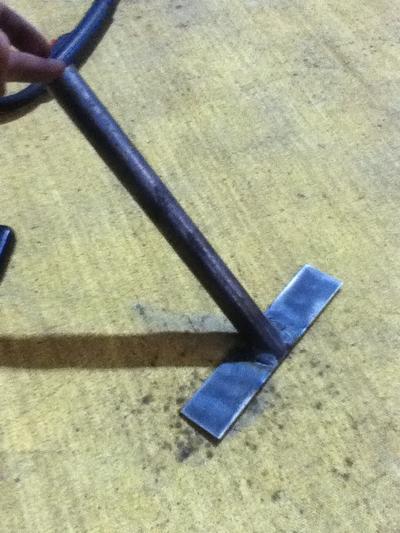
After that, I more or less eyeballed the first gusset to weld on. You could maybe make the rake without the gussets, but they're worth your time and add a lot of strength to the rake head. I made these from the leftover 1-3/4" steel strip, and also cut them out on the bandsaw. Once I eyeballed the first gusset and got it to a shape that filled the area in well, I then traced it onto the other piece of steel and cut it out before I welded anything. If you weld it on first, you won't have your template and won't have two identical gussets, and that just looks UGLY. Then I tacked both joints for each of them and welded them up. I also grinded the welds on the tube down with the flap wheel for good looks, and then re-welded them and ground them back down (just to get the necessary penetration for the welds to be strong, if you grind them down and leave them they will be weak)
This thing should look like this now:
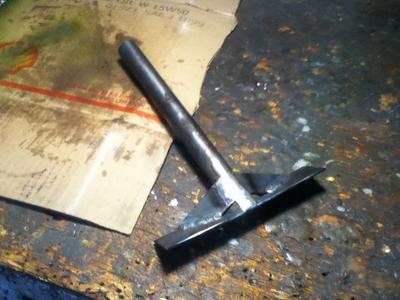
After that I located a hole on each end of the 7" steel strip so that they would be dead center of each side. So I measured 7/8" across and 7/8" down and then used a center punch to make a dimple for the drill bit. Then I drilled the holes with a 5/16" drill bit. Then I drilled the holes on the pipe and made them go 2" down from the top of the pipe (non welded end) and they were spaced 4" apart from eachother. Once again I used a center punch to create a dimple for the drill. Drilling on pipe is a bitch, so I eyeballed the holes the best I could. Hard to get a perfectly centered hole on pipe but just try your best. I used the 5/16" drill bit for this again.
Here it is after I primed, painted, and cleared it, but it should give you an idea of the hole locations:
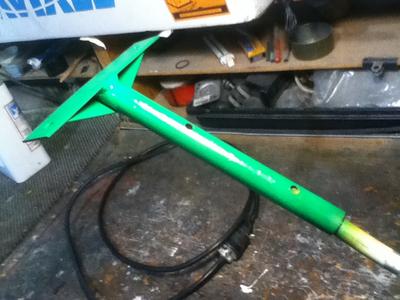
This is the only piece that really needs to be painted/primed because it's made of metal. If you don't it will rust and corrode so quick out in the snow but it is just a rake, so if you don't give a shit then don't even bother with it. The rake head would probably still outlive me if I didn't paint and prime it but whatever, it looks way more legit all painted up.
After we do that , I took the rake head and lined it up on top of the electrical conduit so that the holes would be pretty far inside the conduit, but not so far that the head would be too far in for them to reach when we put the holes in the conduit. Then I drilled the rear hole first using the steel tube as a guide, but only halfway through the conduit. Then I dropped a bolt in this hole to hold it in place, checked to make sure the steel pipe still looked centered over top of the conduit, and then drilled the second hole halfway again, using the steel pipe as a guide. Then I took the steel pipe off and the bolt out and slide it inside the conduit and lined up the holes, then drilled the other half of the conduit, once again pinning the first hole in place and using the pipe as a guide. This gave me an absolutely perfect, tight fit for the 2" long bolts.
The rake is bolted to the rake head here, but it gives you a good idea of how the rake head and conduit should meet:
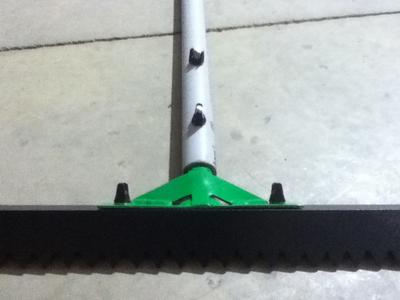
After that I found the center of the 36" angle aluminium, and measured out the hole locations for the rake head bolt holes. Then I just put the rake head up to the rake to make sure the holes looked centered with the marked locations for the holes on the rake. Mine were bang on so I once again center punched the marks, and then drilled the holes with our 5/16" drill bit. Then I threw the bolts through each other to see how they lined up, and what do you know, they lined up perfectly.
After you get the rake and rake head fitted together, it's time to put the serrations into the rake. I hadn't the slightest clue what size I should make them but I chose to make a tooth with a 3/4" spacing between the "peaks" 3/4" deep "valleys" and 3/4" spacing between the valleys.
Here is a shitty MS paint diagram to explain the tooth:
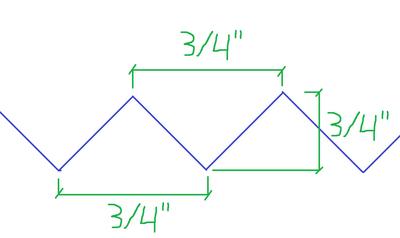
I basically just measured dots along the very bottom of the rake every 3/4", then did the same but offset over 3/8" and up 3/4" to get the tooth pattern like in the pic. Make sure you measure up on the flat piece of the angle that you have not drilled on. Then I just connected the dots on the bandsaw to get the teeth to shape, then cleaned them up using the hand file.
Finished tooth profile:
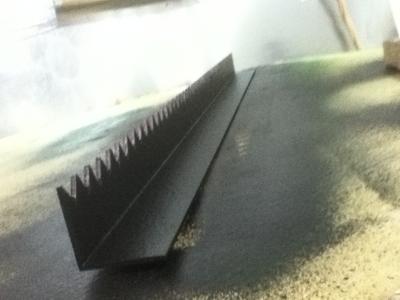
After all that you can paint the rake if you would like (scuff it up with sandpaper, clean it with some reducer) I painted mine with "rocker guard" which I thought was going to absolutely suck, but it's held on very well and just worn off slightly on the teeth which was expected. Gives it a nice textured finish, but a clean and badass look.
http://www.canadiantire.ca/AST/browse/4/Auto/AutoBodyRepair1/AutoBodyPaintProtectants/PRD~0477935P/Black%2BRocker%2BGuard.jsp
After the two are dried up, take the 1/2" bolts and bolt the rake and rake head together with the threads facing up:
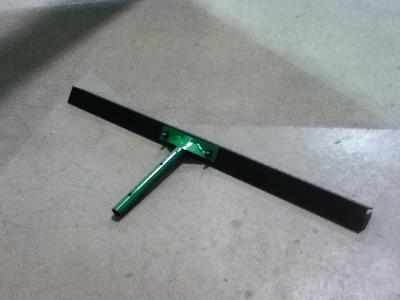
Then bolt the rake head to the conduit handle, with the bolt threads facing up:
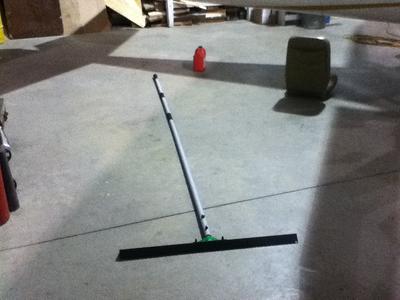
Then the thing is pretty much done. A few optional things, I painted the wingnuts with rocker guard just so they would look badass and stand out in snow should I ever drop one, I used hockey tape on the handle to give it some extra grip, but it's unnecessary, and then I taped a plastic cap on the end of the conduit to keep snow out and to keep it light:
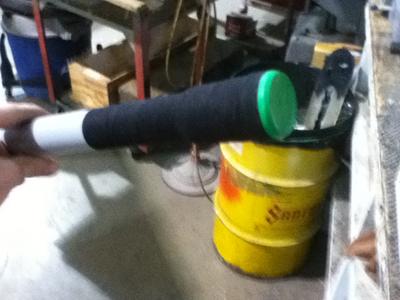
And just like that, you have a pretty badass snow rake. Took me probably 3-4 hours to get this thing done start to finish. You could make it even quicker, but I took my time because I wanted to have a really nice looking piece in the end, and that was the result. Post up any questions if you have any in here, or drop me a PM, I'm sure there will be a few, because that is a lot of poor wording up there... And when you make your own, post it up in here, and post any modifications you may have made to yours. Enjoy!








